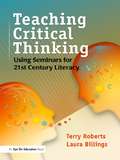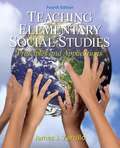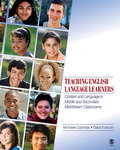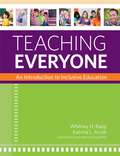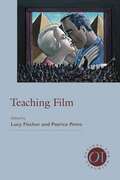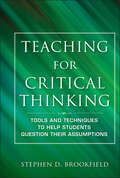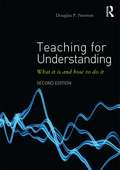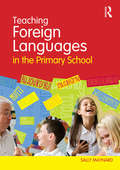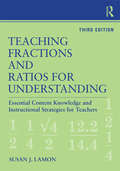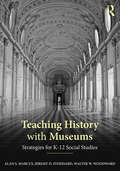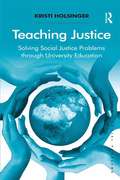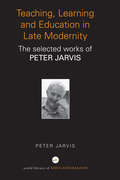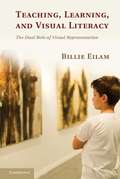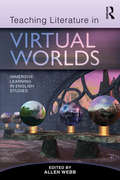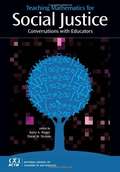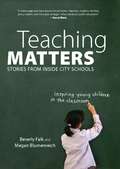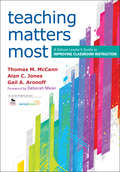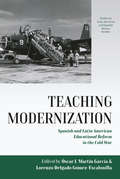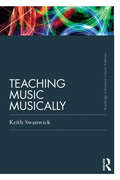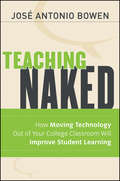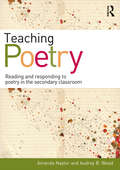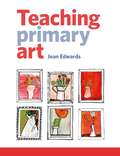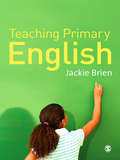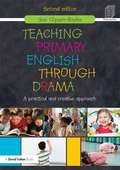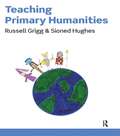- Table View
- List View
Teaching Critical Thinking: Using Seminars for 21st Century Literacy
by Laura Billings Terry RobertsHelp students meet today’s literacy demands with this new book from Terry Roberts and Laura Billings. The authors show how a seminar approach can lead students deeper into a text and improve their speaking, listening, and writing skills, as recommended by the Common Core State Standards. Roberts and Billings provide easy-to-follow information on implementing Paideia Seminars, in which students discuss a text and ask open-ended questions about it. When teachers use this lesson format, students are exposed to a wide range of increasingly complex texts. They also learn how to collaborate, talk about, and reflect on what they’re reading, to make meaning independently and together. Seminars can be done in English class and across the curriculum, using social studies documents or math problems as the texts under discussion. Teaching Critical Thinking also offers an array of practical resources: teacher lesson plans student samples a list of possible ideas and values for discussion a guide to asking good questions during a seminar six full seminar plans (including the texts), covering literature, social studies, and science topics
Teaching Elementary Social Studies: Principles and Applications
by James J. ZarrilloLearn how to meet the needs of the diverse students in your first classroom through this unique elementary social studies methods textbook. With a unifying theme of diversity, it emphasizes differentiated instruction and meeting the needs of all students, including special attention to English learners, children with mild learning disabilities, and gifted students Chapters on differentiated instruction (Chapter 4) and culturally-responsive teaching (Chapter 5) provide a strong foundation and context for the strategies and teaching tips that follow in later chapters. Reflecting the national trends toward standards-based instruction and greater utilization of technology, this book is a great resource for your first classroom and beyond Read and reference this text for comprehensive coverage including new chapters on teaching geography and the literacy and social studies connection, as well as existing chapters on the history and current status of social studies; lesson and unit planning; cooperative learning; critical thinking; technology; assessment; integrating the language arts, the visual arts, and the performing arts; citizenship education; history and geography; and the other social sciences. Finally, instructors and students have praised earlier editions of this book because of its pragmatic and accessible style.
Teaching English Language Learners: 43 Strategies for Successful K-8 Classrooms
by Michaela ColomboIdeal as a supplementary text for a variety of courses and as a guide for in-service teachers and for professional development settings, Teaching English Language Learners: 43 Strategies for Successful K–8 Classrooms provides teachers of all content areas with a broad, practical approach to teaching English language learners in the regular classroom setting.
Teaching Everyone: An Introduction to Inclusive Education
by Whitney H. Rapp Katrina L. ArndtWhitney Rapp & Katrina Arndt developed Teaching Everyone, the first text that fully prepares teachers to see past disability labels and work with all students' individual needs and strengths. Accessible and forward-thinking, this inclusive special education text will get K-12 teachers ready to work effectively within today's schools and meet the learning needs of a wide range of students.
Teaching Film (Options for Teaching #35)
by Mark Lynn Anderson Dudley Andrew Michael Aronson Pat Brereton Timothy Corrigan David Desser Nataša Ďurovičová Gwendolyn Audrey Foster E. Ann Kaplan Mark Langer Adam Lowenstein Paula J. Massood Hamid Naficy Tasha Oren Michael Renov Anne Rutherford Garrett Stewart Maureen Turim Patricia WhiteFilm studies has been a part of higher education curricula in the United States almost since the development of the medium. Although the study of film is dispersed across a range of academic departments, programs, and scholarly organizations, film studies has come to be recognized as a field in its own right. In an era when teaching and scholarship are increasingly interdisciplinary, film studies continues to expand and thrive, attracting new scholars and fresh ideas, direction, and research.Given the dynamism of the field, experienced and beginning instructors alike need resources for bringing the study of film into the classroom. This volume will help instructors conceptualize contemporary film studies in pedagogical terms. The first part of the volume features essays on theory and on representation, including gender, race, and sexuality. Contributors then examine the geographies of cinema and offer practical suggestions for structuring courses on national, regional, and transnational film. Several essays focus on interdisciplinary approaches, while others describe courses designed around genre (film noir, the musical), mode (animation, documentary, avant-garde film), or the formal elements of film, such as sound, music, and mise-en-scène. The volume closes with a section on film and media in the digital age, in which contributors discuss the opportunities and challenges presented by access to resources, media convergence, and technological developments in the field.
Teaching for Critical Thinking
by Stephen D. BrookfieldAccording to AAC&U's 2013 employer survey, 93% of employers agree that a candidate's "demonstrated capacity to think critically, communicate clearly, and solve complex problems" is more important than their undergraduate major. Likewise, more than three in four employers say they want colleges to place more emphasis on helping students develop critical thinking skills. In Teaching for Critical Thinking, Stephen Brookfield builds on his last three decades of experience running workshops and teaching courses on critical thinking to explore how student learn to think this way, and what teachers can do to help students develop this capacity. He outlines a basic protocol of critical thinking as a learning process that focuses on uncovering and checking assumptions, exploring alternative perspectives, and taking informed actions as a result. Written to address the broad range of disciplines, this book fosters a shared understanding of critical thinking and helps to various constituencies adapt general principles to specific disciplinary contexts.
Teaching for Understanding: What it is and how to do it
by Douglas P NewtonFirst published in 2012. Routledge is an imprint of Taylor & Francis, an informa company.
Teaching Foreign Languages in the Primary School
by Sally MaynardTeaching Foreign Languages in the Primary School is for every teacher –whether generalist or specialist, trainee or experienced – wanting to confidently introduce foreign language teaching into their classroom. Based on the author’s extensive experience of teaching across Key Stages 1-2, this book provides practical strategies that can be easily implemented in your setting. Offering comprehensive guidance on the pedagogy that underpins language teaching, it covers everything you’ll need to teach foreign languages effectively: Planning, teaching and assessment Pedagogical approaches Integrating primary languages across the curriculum Where to find and how to use good resources Using TAs effectively to support language learning Inclusive practice Using ICT in language teaching How to promote children’s intercultural understanding Illustrated with useful lesson ideas and a range of examples from the classroom, Teaching Foreign Languages in the Primary School is an indispensable source of support for all student and practising primary school teachers.
Teaching Fractions and Ratios for Understanding: Essential Content Knowledge and Instructional Strategies for Teachers
by Susan J. LamonFor over a decade, Teaching Fractions and Ratios for Understanding has pushed readers beyond the limits of their current understanding of fractions and rational numbers, challenging them to refine and explain their thinking without falling back on rules and procedures they have relied on throughout their lives. All of the material offered in the book has been used with students, and is presented so that readers can see the brilliance of their insights as well as the issues that challenge their understanding. Written in a user-friendly, conversational style, this text helps teachers build the comfort and confidence they need to begin talking to children about fractions and ratios. The clear distillation of complex ideas and the translation of research into usable ideas for the classroom make this text a valuable resource for all pre- and in-service mathematics teachers. The highly anticipated third edition of this popular text has been heavily expanded and reorganized to make the connectivity of topics even more transparent, including more mathematics content, teaching/reasoning techniques, classroom activities, connections to other content, and applications to everyday life. In addition, the most effective features from previous editions have been retained. Special Features: Children’s Strategies and samples of student work are provided in each chapter for teacher analysis. Activities for practicing the thinking strategies explained in each chapter, designed to be solved without rules or algorithms, using reasoning alone. Online Resources for Instructors including a sample syllabus, chapter overviews and relevant Big Content ideas for each chapter, and graphics that can be copied and resized for use in instruction and in constructing exams. An equally valuable component of this text is MORE! Teaching Fractions and Ratios for Understanding, Third Edition---a supplement that is not merely an answer key but a resource that provides the scaffolding for this groundbreaking approach to fraction and ratio instruction. Also heavily expanded, MORE! includes in-depth discussions of selected problems in the main text, supplementary activities, Praxis preparation questions, more student work, and templates for key manipulatives.
Teaching History with Museums: Strategies for K-12 Social Studies
by Alan S. Marcus Jeremy D. Stoddard Walter W. WoodwardTeaching History with Museums provides an introduction and overview of the rich pedagogical power of museums. In this comprehensive textbook, the authors show how museums offer a sophisticated understanding of the past and develop habits of mind in ways that are not easily duplicated in the classroom. Using engaging cases to illustrate accomplished history teaching through museum visits, this text provides pre- and in-service teachers, teacher educators, and museum educators with ideas for successful visits to artifact and display-based museums, historic forts, living history museums, memorials, monuments, and other heritage sites. Each case is constructed to be adapted and tailored in ways that will be applicable to any classroom and encourage students to think deeply about museums as historical accounts and interpretations to be examined, questioned, and discussed.
Teaching Justice: Solving Social Justice Problems through University Education (Solving Social Problems)
by Kristi HolsingerTeaching Justice explores the role that teaching and learning in higher education can play in solving problems of social injustice. Examining a range of approaches to education, it considers the challenges that exist in teaching about justice, drawing on extensive empirical data gathered amongst college lecturers and professors, as well as the author's own experience. With an analysis of the strategies commonly used this book will shed light on the manner in which students can be engaged in activism and concerned with issues of social injustice. By overcoming apathy and engaging students with social problems, education can thus address matters of injustice and begin to effect change. Presenting extensive international research and insightful analyses, Teaching Justice reveals the classroom and the lecture theatre to be important sites in the pursuit of social justice and will appeal to teachers and researchers with interests in social problems, education and educational methods, and criminal justice, as well as community engagement and service learning outside the classroom.
Teaching, Learning and Education in Late Modernity: The Selected Works of Peter Jarvis
by Peter JarvisProfessor Peter Jarvis has spent over 30 years researching, thinking and writing about some of the key and enduring issues in education. He has contributed well over 30 books and 200 papers and chapters in books on learning theory, adult education and learning, continuing professional education, nurse education, primary school education, distance education and third age education. In this book, he brings together 19 key writings in one place. Starting with a specially written Introduction, which gives an overview of Peter’s career and contextualises his selection within the development of the field, the chapters cover: Learning Learning and Spirituality Learning and Doing Teaching The End of Modernity Learning in Later Life. This book not only shows how Peter's thinking developed during his long and distinguished career; it also gives an insight into the development of the fields to which he contributed. In the World Library of Educationalists, international scholars themselves compile career-long collections of what they judge to be their finest pieces – extracts from books, key articles, salient research findings, major theoretical and/practical contributions – so the world can read them in a single manageable volume. Readers will be able to follow the themes and strands of their work and see their contribution to the development of a field, as well as the development of the field itself. Contributors to the series include: Richard Aldrich, Stephen J. Ball, John Elliott, Elliot Eisner, Howard Gardner, John Gilbert, Ivor F. Goodson, David Labaree, John White, E.C. Wragg .
Teaching, Learning, and Visual Literacy
by Billie EilamVisual literacy is an increasingly critical skill in a globalizing, digital world. This book addresses the core issues concerning visual literacy in education, underscoring its importance for the instruction of students and educators. Professor Billie Eilam argues that the incorporation of visual skill development in teacher training programs will help break the cycle of visual illiteracy. Understanding the pedagogical benefits and risks of visual representation can help educators develop effective strategies to produce visually literate students. Eilam presents a broad overview of theoretical knowledge regarding visual representation, as well as a discussion of best practices for the use of visual elements in schools. In addition to theory, Eilam includes practical exercises for introducing visual literacy into teacher education, offering strategies for analyzing visualization in curricula and for increasing awareness of visual culture.
Teaching Literature in Virtual Worlds: Immersive Learning in English Studies
by Allen WebbWhat are the realities and possibilities of utilizing on-line virtual worlds as teaching tools for specific literary works? Through engaging and surprising stories from classrooms where virtual worlds are in use, this book invites readers to understand and participate in this emerging and valuable pedagogy. It examines the experience of high school and college literature teachers involved in a pioneering project to develop virtual worlds for literary study, detailing how they created, utilized, and researched different immersive and interactive virtual reality environments to support the teaching of a wide range of literary works. Readers see how students role-play as literary characters, extending and altering character conduct in purposeful ways ,and how they explore on-line, interactive literature maps, museums, archives, and game worlds to analyze the impact of historical and cultural setting, language, and dialogue on literary characters and events. This book breaks exciting ground, offering insights, pedagogical suggestions, and ways for readers to consider the future of this innovative approach to teaching literary texts.
Teaching Mathematics for Social Justice: Conversations with Educators
by David W. Stinson Anita A. WagerMathematics as a Catalyst for Change for ALL Students. <P><P>Educators increasingly recognize the important role that mathematics teaching plays in helping students to understand and overcome social injustice and inequality. This collection of original articles is the start of a compelling conversation among some of the leading figures in critical and social justice mathematics, a number of teachers and educators who have been inspired by them and who have inspiring stories of their own to tell and any reader interested in the intersection of education and social justice. An important read for every educator, this book shows how to teach mathematics so that all students are given the tools they need to confront issues of social justice today and in the future.
Teaching Matters
by Megan Blumenreich Beverly FalkAs public schools become increasingly embattled by budget shortfalls, crowded buildings, and ever-more-rigid curricula, the burden of these restrictions has drastically changed the way children are expected to learn. Nowhere is this more obvious or more devastating than classrooms in high-need urban areas. Drawing upon teachers' firsthand experiences in some of today's most demanding schools, leading education experts Beverly Falk and Megan Blumenreich provide an enlightening account of what our students really need-and how teachers are stepping up to provide what state standards and political posturing cannot.Teaching Matters takes us into a variety of classrooms to witness the art of teaching at its most creative and effective, with a focus on early childhood and elementary school. We follow educators as they strive to change systems that fail to address the needs of their students, from efforts to break the silence about homophobia in schools and multipronged strategies to build stronger relationships with immigrant families to the modification of ineffective curriculum to foster the growth of the "whole child." By confronting many misconceptions about urban education and school reform, Falk and Blumenreich provide a crucial insider's look at some of the most challenging and relevant questions in education today.
Teaching Matters Most: A School Leader’s Guide to Improving Classroom Instruction
by Thomas M. McCann Alan C. Jones Gail A. AronoffA laser-beam focus on improving instruction to improve learning If we want to change how students write, compute, and think, then teachers must transform the old “assign-and-assess” model into engaging, coherent, and rigorous instruction. The authors show school leaders how to make this happen amidst myriad distractions, initiatives, and interruptions. Unlike other books that stop at evaluating teachers and instruction, this work demonstrates how to grow schools’ instructional capacities with a three-step process that involves: Envisioning what good teaching looks like Measuring the quality of current instruction against this standard Working relentlessly to move the quality of instruction closer and closer to the ideal
Teaching Modernization: Spanish and Latin American Educational Reform in the Cold War (Studies in Latin American and Spanish History #6)
by Óscar J. Martín García Lorenzo Delgado Gómez-EscalonillaIn the 1960s and 1970s, the educational systems in Spain and Latin America underwent comprehensive and ambitious reforms that took place amid a "revolution of expectations" arising from decolonization, global student protests, and the antagonism between capitalist and communist models of development. Deploying new archival research and innovative perspectives, the contributions to this volume examine the influence of transnational forces during the cultural Cold War. They shed new light on the roles played by the United States, non-state actors, international organizations and theories of modernization and human capital in educational reform efforts in the developing Hispanic world.
Teaching Music Musically (Classic Edition)
by Keith Swanwick'There are countless gems within these pages ... Swanwick seems to write from more experience as a musician and teacher than most others who write for this audience. There is a real sense of his having been there. - Patricia Shehan Campbell, Professor of Music, University of Washington, USA'... contains the essential and highly valued hallmark of
Teaching Naked
by José Antonio BowenYou've heard about "flipping your classroom"--now find out how to do it! Introducing a new way to think about higher education, learning, and technology that prioritizes the benefits of the human dimension. José Bowen recognizes that technology is profoundly changing education and that if students are going to continue to pay enormous sums for campus classes, colleges will need to provide more than what can be found online and maximize "naked" face-to-face contact with faculty. Here, he illustrates how technology is most powerfully used outside the classroom, and, when used effectively, how it can ensure that students arrive to class more prepared for meaningful interaction with faculty. Bowen offers practical advice for faculty and administrators on how to engage students with new technology while restructuring classes into more active learning environments.
Teaching Poetry: Reading and responding to poetry in the secondary classroom
by Amanda Naylor Audrey B. WoodTeaching Poetry is an indispensible source of guidance, confidence and ideas for all those new to the secondary English classroom. Written by experienced teachers who have worked with the many secondary pupils who ‘don’t get’ poetry, this friendly guide will help you support pupils as they access, understand, discuss and enjoy classic and contemporary poetry. With an emphasis on active approaches and the power of poetry to enrich the lives of both teachers and students, Teaching Poetry: Provides a succinct introduction to the major ideas and theory about teaching poetry Covers the key genres and periods through tried and tested favourites and a range of less well known new and historical poetry Illustrates good practice for every approach covered, through case studies of theory and ideas in action in the classroom Includes activities, ideas and resources to support teaching at Key Stages 3, 4 and 5. Teaching Poetry tackles head on one of the aspects of English teaching that new and experienced teachers alike find most difficult. It offers both a comprehensive introduction to teaching poetry and a rich source of inspiration and support to be mined when faced with an unfamiliar text or an unresponsive class.
Teaching Primary Art
by Jean EdwardsTeaching Primary Art is an introductory textbook for those training to teach and support learning in art in the primary school. The book first explores the underpinning philosophy and pedagogy of teaching and learning art, including why we teach it; planning and assessment; and teaching and support strategies. Then it covers the practical aspects of teaching art, including a list of useful vocabulary to encourage talk around art and links to cross-curricular learning.
Teaching Primary English
by Jackie BrienShortlisted for the UKLA Academic Book Award 2013! Literacy empowers learning across the whole curriculum and language is at the centre of all learning in primary education. Aware of current curriculum developments and drawing from the latest research Teaching Primary English encourages teacher education students to develop a deeper understanding of the essential issues involved in teaching English in order to approach a career in the primary classroom with the confidence and knowledge required to succeed. Taking a fresh approach to the main elements of teaching primary English, Jackie Brien strikes an engaging balance between the practical requirements of English teaching and encouraging informed reflection on key aspects of primary literacy. This is essential reading for everyone studying primary English on primary initial teacher education courses including undergraduate (BEd, BA with QTS), postgraduate (PGCE, SCITT), and employment-based routes into teaching. Jackie Brien is Curriculum Leader for English, Communication, Language and Literacy at the University of Chester.
Teaching Primary English through Drama: A practical and creative Approach
by Suzi Clipson-Boyles"The text is extraordinarily succinct, very well organised and highly readable. Each chapter examines in depth specific aspects of teaching and learning in drama and well-chosen practical examples can readily be adopted by teachers. A 'must' for all primary schools." Drama (the Journal of National Drama) Review of ‘Drama in Primary English teaching’ Teaching Primary English through Drama builds on the success of the classic text Drama in Primary English, inspiring ideas and techniques for teaching English skills through the medium of drama. Focusing on the power of drama to promote effective learning in primary education, Suzi Clipson-Boyles demonstrates how reading, writing, speaking and listening skills may be developed in ways that will motivate and engage pupils. She uses specific examples from the English curriculum, and also makes links to other areas of the curriculum. In addition, the book explains how assessment during drama can help teachers to evaluate pupils’ progress in English. Further guidance is given on how drama can enrich studying for pupils who are learning English as a foreign language. The book also provides a chapter on developing drama as an art form in its own right, with simple ideas and practical suggestions on how to enhance performances. Teaching Primary English through Drama presents a wide range of drama approaches from ten-minute starter activities to stimulate ideas such as fun ways to practise reading, through to longer projects that can provide contexts for extended writing or help with presentation and performance. The chapters show how drama can help to bring lessons alive in imaginative ways that not only promote enjoyment but also enhance achievement. This comprehensive and practical guide offers essential reading for primary teachers and other practitioners, and is a valuable resource to trainees. It also provides an excellent foundation for those who wish to extend their expertise further towards drama as a subject specialism.
Teaching Primary Humanities
by Russell GriggAs primary subjects are increasingly being taught on an interdisciplinary level, Russell Grigg and Sioned Hughes have created an innovative new text, Teaching Primary Humanities. This new text explores current debate, encourages reflection and provides clear guidance on planning, teaching and assessing the humanities from the Early Years to Key Stage 2. Through a blend of theory and real-life examples, Grigg and Hughes demonstrate the contribution that history, geography and religious education can make to enhancing children’s thinking, literacy, numeracy and ICT skills.Whether you are a trainee or a practitioner, this book will develop your knowledge of how young children’s understanding of place, time and community can be fostered through a play-based curriculum. It will also benefit teachers of older children looking to encourage more independent learning in their schools.About the authors:Dr Russell Grigg is Head of the South West Wales Centre of Teacher Education. He is a trained primary inspector for England and Wales. He has written widely in the field of history and primary education including Wales in the Victorian Age and Becoming an Outstanding Primary Teacher. Dr Sioned Hughes is Senior Lecturer in Initial Teacher Training at the South West Wales Centre of Teacher Education. She has published many educational materials, especially in primary geography. Her work on Patagonia was recognised by the Welsh Books Council as the ‘Bestselling Children’s Book’ in 2011.
